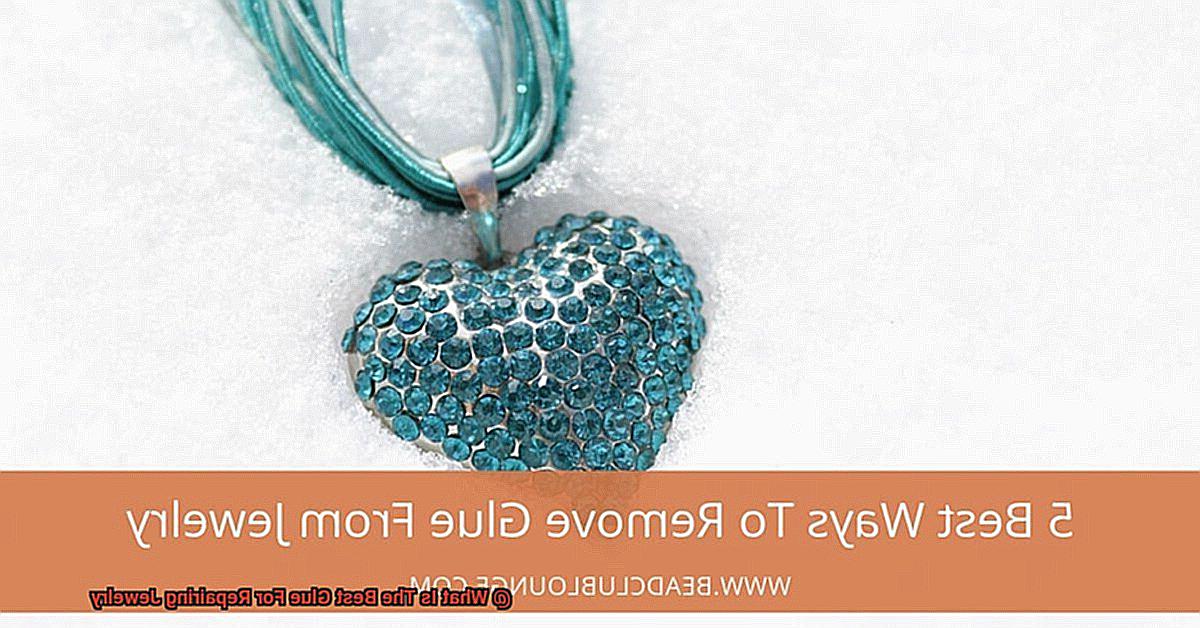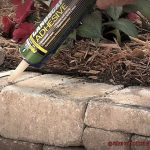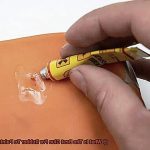We’ve all been there – that gut-wrenching moment when your beloved necklace or bracelet snaps into pieces. But fear not.
We’re here to save the day (and your jewelry) by revealing the secret to successful repairs: the best glue for the job. Whether you’re dealing with dainty gemstones or tough-as-nails metal settings, we’ve got you covered.
Get ready to bring your treasured pieces back to life with our expert recommendations.
Factors to Consider When Choosing the Best Glue for Jewelry Repairs
Contents
- 1 Factors to Consider When Choosing the Best Glue for Jewelry Repairs
- 2 Epoxy Resin Glue
- 3 Cyanoacrylate Glue (Super Glue)
- 4 Clear Drying Adhesives
- 5 Pros and Cons of Different Types of Glues for Jewelry Repair
- 6 Tips for Applying the Right Glue to Jewelry Repairs
- 7 Common Mistakes to Avoid When Using Glue for Jewelry Repairs
- 8 Conclusion
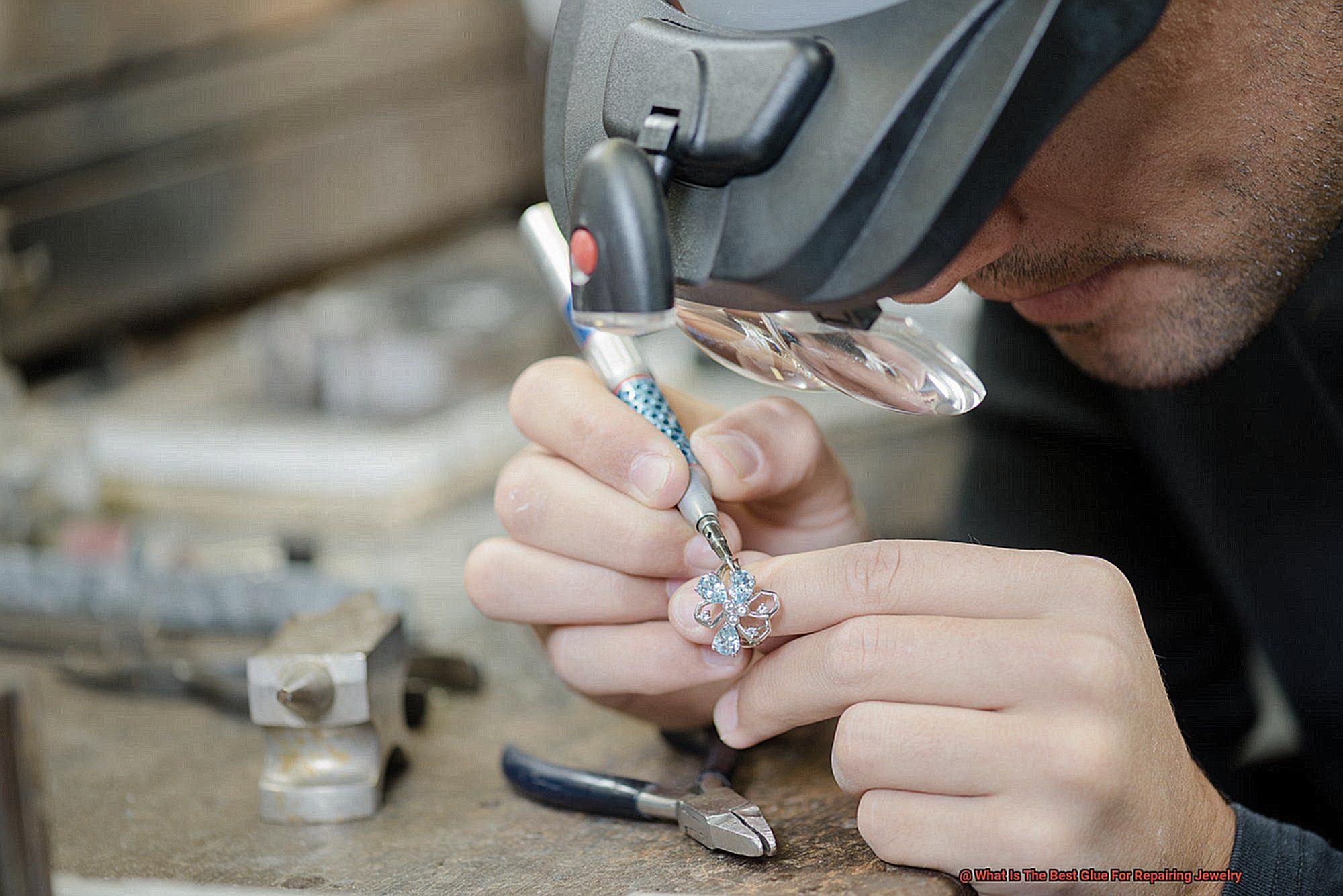
When repairing your precious jewelry, it’s crucial to use the right glue. The wrong adhesive can ruin the aesthetics, compromise structural integrity, or even cause damage. To ensure successful and long-lasting repairs, consider these factors when choosing the best glue for your jewelry repairs.
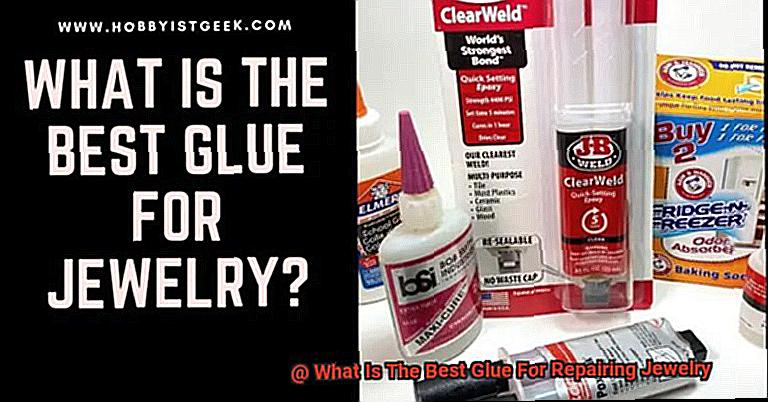
Factor 1: Adhesive Strength
To keep your repaired jewelry intact, opt for glues with high adhesive strength. Look for “super strength” or “extra strong” glues that specifically mention their strength on the packaging. These glues create robust bonds that withstand everyday wear and tear.
Factor 2: Drying Time
Precision is vital in jewelry repairs, so choose quick-drying glues. Look for glues that dry within minutes to avoid prolonged waiting times and continue working promptly.
Factor 3: Transparency
Maintain your jewelry’s aesthetics by selecting a glue that dries clear or transparent. This ensures seamless blending with the rest of the piece. Avoid glues with a yellowish or cloudy appearance that detract from your jewelry’s beauty.
Factor 4: Flexibility
Choose a glue that can withstand frequent movement and stress for jewelry items like bracelets and rings. Look for glues designed for flexible materials or those mentioning flexibility on the packaging.
Factor 5: Chemical Compatibility
Ensure the glue is compatible with your jewelry material to prevent negative reactions. Read instructions or consult a jeweler to avoid damaging your precious pieces.
Factor 6: Water Resistance
For water-exposed jewelry like earrings or necklaces, choose water-resistant or waterproof glues. Prevent deterioration or loss of bond when exposed to moisture.
Factor 7: Ease of Use
Consider application methods and ease of use. Some glues come in tubes with precision applicators, while others may require mixing or have complicated processes. Choose a glue suitable for your comfort level and skill to ensure easy and mess-free application.
Factor 8: Longevity
Select a glue marketed as long-lasting or durable to ensure your repaired jewelry stays intact without frequent reapplication.
Epoxy Resin Glue
Epoxy resin glue is here to swoop in and revive your bling with its incredible bonding power.
Let’s dive into why epoxy resin glue is the ultimate choice for jewelry repairs. First off, this glue means serious business when it comes to creating a strong bond. With its two-component formula – a resin and a hardener – epoxy resin glue initiates a chemical reaction that forms an unbreakable adhesive. It can handle the everyday wear and tear without breaking a sweat.
But strength isn’t the only superpower of epoxy resin glue. Its versatility is simply mind-boggling. Whether you need to fix metal, glass, gemstones, or even plastic, this glue has got your back. No matter what materials make up your jewelry, epoxy resin glue can tackle the task effortlessly.
Now let’s talk about aesthetics. We all want our repaired jewelry to look as flawless as new, right? Well, fear not. Epoxy resin glue dries clear and becomes virtually invisible when applied correctly. Say goodbye to unsightly residue or discoloration on your precious pieces – epoxy resin glue ensures a seamless repair that will leave your jewelry looking exquisite.
And let’s not forget about durability. Once epoxy resin glue is fully cured (which typically takes around 24 hours), it forms a bond that can withstand daily use and movement. So feel free to flaunt your favorite ring or bracelet with confidence – epoxy resin glue has got your bling covered.
And guess what? Water and chemicals are no match for epoxy resin glue. It’s renowned for its resistance to both. So whether you find yourself caught in a sudden rainstorm or splashing around at the beach, rest assured that your repaired jewelry will remain intact.
But remember, not all epoxy resin glues are created equal. Be sure to choose a high-quality brand specifically designed for jewelry repairs. And always follow the manufacturer’s instructions for optimal results.
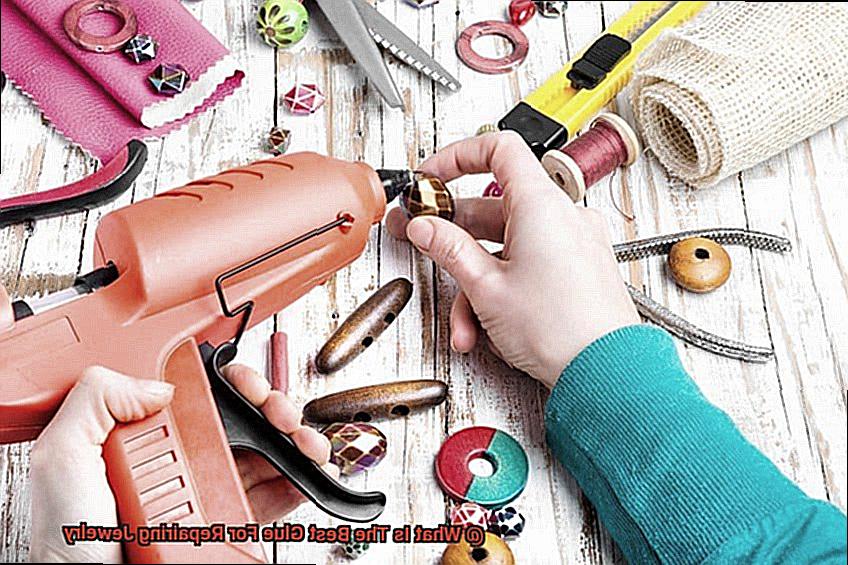
Cyanoacrylate Glue (Super Glue)
We have a superhero in the world of jewelry repair: cyanoacrylate glue, also known as super glue. This extraordinary adhesive is here to save the day and resurrect your precious pieces. Let’s delve into the remarkable properties and considerations of using cyanoacrylate glue for jewelry repair.
Advantages:
- Lightning-fast Bonding: Time is of the essence when it comes to repairing jewelry, and cyanoacrylate glue sets within a matter of seconds to minutes. No more waiting around for ages.
- Herculean Strength: Super glue boasts exceptional tensile strength, allowing it to withstand significant force and tension once fully cured. Say goodbye to flimsy repairs – your jewelry will be held together securely.
- Versatility at Its Finest: Whether you’re dealing with metal, glass, plastic, or even certain gemstones commonly found in jewelry, cyanoacrylate glue rises to the challenge. It forms a reliable bond with various surfaces, making it the go-to choice for diverse repair needs.
Considerations:
- Cleanliness is Key: To ensure a solid bond, it is crucial that the surfaces being bonded are clean and free from oils or contaminants. A quick wipe with rubbing alcohol or acetone does wonders.
- Less is More: Applying excessive amounts of super glue can result in messy and unsightly bonds. For most jewelry repairs, a small drop or thin bead of glue is usually sufficient.
- Compatibility Check: While super glue is generally durable and long-lasting, it may not be suitable for all types of jewelry repairs. Before applying it to the actual repair area, perform a test on a small and inconspicuous section to avoid any potential damage.
With its lightning-fast bonding, impressive strength, and compatibility with various materials, cyanoacrylate glue (super glue) is a formidable ally for jewelry repair. Just remember to keep surfaces clean, use it sparingly, and test it beforehand.
Clear Drying Adhesives
These adhesive superheroes possess the remarkable power of drying clear, leaving no trace of unsightly residue on the jewelry’s surface. Say goodbye to repaired pieces that look, well, repaired. Clear drying adhesives are specially formulated to bond various materials commonly found in jewelry, including metal, glass, ceramic, and even certain types of plastic.
Now, let’s dive into the benefits of using clear drying adhesives for jewelry repair:
- Seamless Bonding: These adhesives are masters at creating seamless bonds between broken or detached jewelry components. No more pesky gaps or wobbly pieces. Your repaired jewelry will look as good as new.
- Versatility: Clear drying adhesives have the incredible ability to handle a wide range of jewelry materials. From delicate earrings to sturdy bracelets, these adhesives are perfect for all your repair needs.
- Easy Application: Need a liquid glue or a gel adhesive? The choice is yours. Both options offer easy application and quick drying times. Plus, with precision applicator tips, you can reach even the tiniest nooks and crannies of your jewelry.
- Durability: When you need a strong bond that can withstand the test of time, epoxy resin is here to save the day. This two-part adhesive requires mixing but offers an incredibly strong hold for those more complex repairs.
When selecting the perfect adhesive for your jewelry repairs, consider factors such as compatibility with the materials being bonded, drying time, and the strength of the bond. And don’t forget to test it out on a small, inconspicuous area before committing to the full repair.
Pros and Cons of Different Types of Glues for Jewelry Repair
When it comes to repairing jewelry, selecting the right glue is crucial for achieving a successful outcome. With a wide range of glues available, it’s important to understand their advantages and disadvantages to make an informed decision. In this article, we will explore the pros and cons of various glues commonly used for jewelry repair, helping you choose the most suitable option.
Epoxy Glue:
Epoxy glue is renowned for its strong bond and exceptional durability, making it ideal for a variety of materials such as metal, glass, and gemstones. Its versatility allows for different types of repairs. However, one drawback of epoxy glue is its longer drying time, requiring patience during the repair process. Additionally, the need to mix epoxy glue before use can be a minor inconvenience. Careful handling is also necessary to avoid any accidental skin contact due to its sticky nature.
Super Glue:
Super glue, or cyanoacrylate adhesive, is popular for its rapid bonding and quick drying properties. It excels at creating strong bonds on non-porous surfaces, making it perfect for small-scale repairs. Nevertheless, super glue may not possess the same level of strength as epoxy glue and can become brittle over time. Furthermore, it is not recommended for use on porous gemstones or soft metals as it may cause damage.
Jewelry Glue:
Designed specifically for bonding jewelry materials like metal, glass, and beads, jewelry glue offers a clear and flexible bond that is ideal for delicate repairs. Its ability to create invisible connections makes it perfect for preserving the aesthetic appeal of jewelry. However, compared to epoxy or super glue, jewelry glue may not provide the same level of strength and durability. Thus, it is best suited for lightweight repairs rather than heavy-duty applications.
Adhesive Tapes:
Adhesive tapes provide a convenient and easy-to-apply option for temporary fixes in jewelry repair. They are particularly useful for quick solutions. However, adhesive tapes may not deliver a long-lasting or secure bond compared to glues. Therefore, they are best used as temporary measures until a more permanent repair can be undertaken.
Considerations:
When selecting a glue for jewelry repair, it is essential to consider factors such as the type of material being repaired, the size of the repair area, and the desired strength of the bond. Consulting a professional jeweler for advice on the most appropriate adhesive is also crucial, especially when dealing with porous materials or delicate gemstones.
Tips for Applying the Right Glue to Jewelry Repairs
When it comes to repairing jewelry, selecting the appropriate glue is of utmost importance. The wrong adhesive can lead to weak bonds, discoloration, or even further damage to the piece. In this article, we will explore the significance of choosing the right glue for jewelry repairs and provide valuable tips for successful application.
Consider the materials:
Different types of jewelry are crafted from various materials such as metal, glass, plastic, or gemstones. It is crucial to choose a glue that is specifically designed for the materials you are working with. By doing so, you ensure a strong and durable bond that will withstand the test of time. For example, when repairing a metal necklace, opt for a jewelry epoxy or super glue formulated for metal. Delicate gemstones, on the other hand, may require a specialized adhesive for gemstone setting.
Opt for a clear and strong adhesive:
Selecting a clear adhesive that dries transparently is essential in jewelry repairs. This ensures that no visible residue or discoloration is left on the piece. Additionally, it is important to choose an adhesive that provides a strong bond to ensure the repair holds up over time. Look for glues with high tensile strength that are specifically marketed for jewelry repairs.
Test on a small area:
Before applying glue to the entire repair area, it is wise to conduct a test on a small, inconspicuous part of the jewelry. This allows you to check if the glue reacts negatively with the material or causes any discoloration. By testing first, you can avoid potential damage to valuable or sentimental pieces and make necessary adjustments if needed.
Use small amounts:
When applying glue to jewelry repairs, remember that less is often more. Using excessive amounts of glue can result in seepage and visible residue on the piece. To prevent this, apply small amounts precisely where needed. If the initial bond is not strong enough, you can always add more glue later.
Allow proper drying time:
After applying the glue, it is crucial to allow sufficient time for it to dry and set. Rushing the drying process can result in a weak bond that may easily break. To ensure a strong and durable repair, follow the manufacturer’s instructions for the recommended drying time. Avoid handling or wearing the repaired jewelry until the glue has fully cured.
Common Mistakes to Avoid When Using Glue for Jewelry Repairs
Repairing jewelry is a satisfying and cost-effective way to restore your favorite pieces. However, using the wrong glue or making common mistakes during the repair process can lead to disappointing results. In this article, we will explore some of the most common mistakes to avoid when using glue for jewelry repairs. By being aware of these mistakes, you can ensure that your repairs are successful and long-lasting.
Using the Wrong Type of Glue:
Not all glues are created equal, especially when it comes to jewelry repairs. One of the most common mistakes is using the wrong type of glue, which can cause damage to delicate gemstones or precious metals. To avoid this mistake, make sure to use a specialized jewelry glue that is designed specifically for the type of material you are working with. For example, super glue may work well on metal but can damage porous gemstones like pearls or opals.
Applying Too Much Glue:
Another common mistake when repairing jewelry is using excessive amounts of glue. Many people believe that more glue means a stronger bond, but this is not always the case. In fact, applying too much glue can make the repair look messy and unprofessional. It is important to use just enough glue to create a strong bond without overwhelming the piece. This will also make it easier to clean off any excess glue before it dries.
Not Cleaning the Surfaces Properly:
Jewelry often comes into contact with oils, dirt, and residue from cosmetics or lotions, which can prevent the glue from adhering properly. Neglecting to clean the surfaces thoroughly before applying glue is a common mistake. To ensure a strong hold, it is crucial to clean the surfaces using a mild soap and water solution or rubbing alcohol. This will remove any contaminants and allow the glue to bond effectively.
Rushing the Drying Time:
Patience is key when it comes to drying time for jewelry repairs. Rushing the process can result in a weak bond that may break easily. It is important to allow enough time for the glue to dry and set properly before wearing or handling the repaired piece. Follow the manufacturer’s instructions for drying times and avoid touching or moving the jewelry until it has fully cured. Taking the time to properly dry your jewelry will ensure a secure and long-lasting repair.
Using Glue as a Long-Term Solution:
While glue can be a quick fix for minor damages, it may not provide a permanent solution for more significant repairs. Using glue as a long-term solution is a common mistake that should be avoided. If your jewelry has structural damage or requires intricate repairs, it is best to seek professional assistance from a jeweler or jewelry repair specialist. They have the expertise and proper tools to ensure a durable and lasting repair.
do2KCicuKlQ” >
Conclusion
In conclusion, selecting the perfect glue for repairing your precious jewelry is absolutely crucial if you want your repairs to last. There are several factors that must be taken into account when choosing the right adhesive: strength, drying time, transparency, flexibility, chemical compatibility, water resistance, ease of use, and longevity.
One exceptional choice for jewelry repairs is epoxy resin glue. This powerhouse adhesive forms an unbreakable bond that can withstand the rigors of everyday wear and tear. It’s a versatile option that can be used on a variety of materials including metal, glass, gemstones, and plastic. When applied correctly, it dries clear and becomes virtually invisible. Plus, it’s incredibly durable and resistant to both water and chemicals.
For lightning-fast bonding with impressive tensile strength, cyanoacrylate glue (super glue) is another excellent option for fixing jewelry. However, keep in mind that it may not be suitable for all types of repairs and should be tested beforehand.
If you’re looking for seamless bonds without any residue left behind on your jewelry’s surface, clear drying adhesives are the way to go.
When applying glue to repair your beloved jewelry pieces, remember to consider the materials being bonded. Use small amounts of glue precisely where needed and allow ample drying time before handling the repaired piece. Rushing the process or using the wrong type of glue are common mistakes to avoid at all costs.

